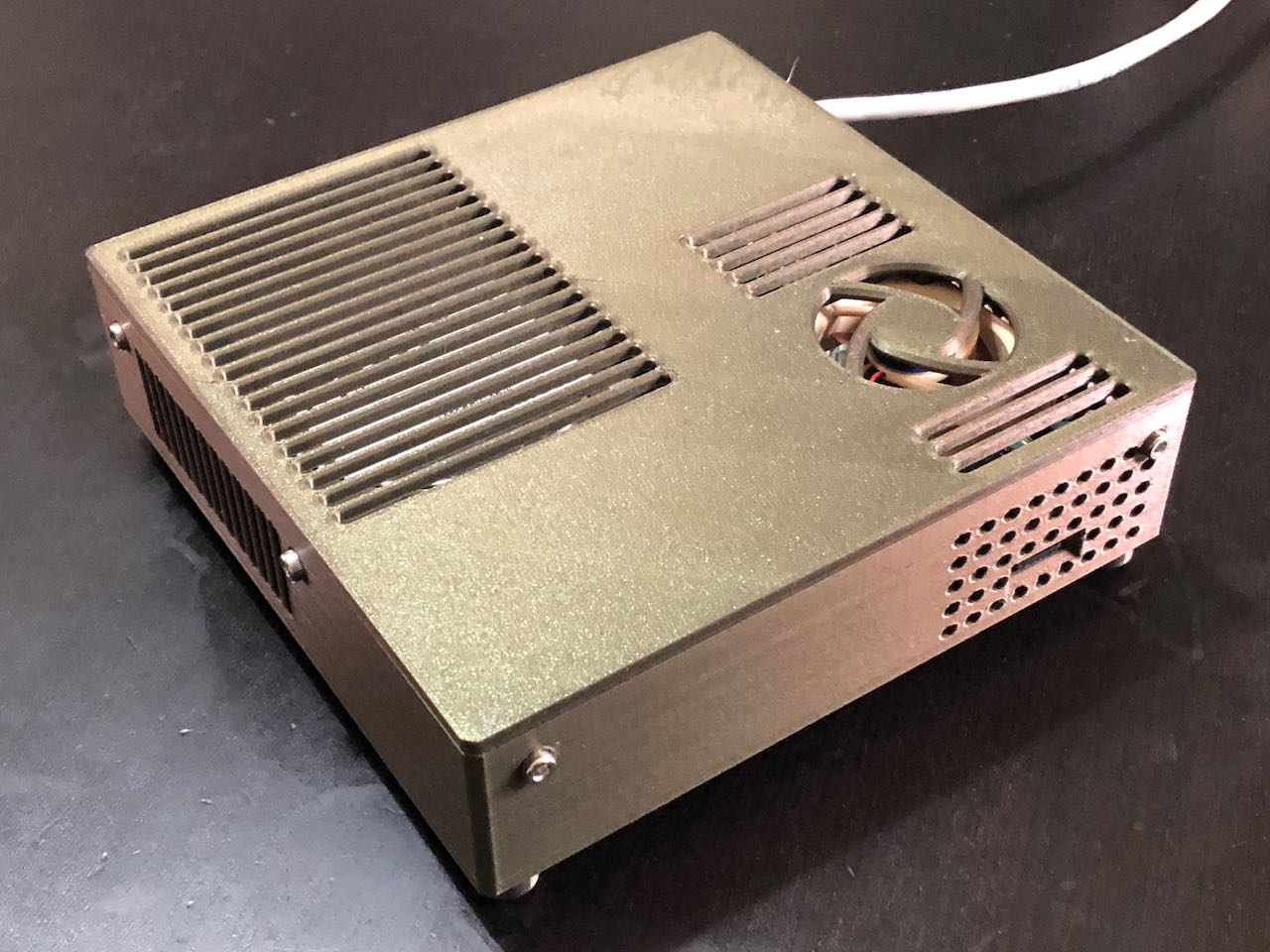
Dual HDD Raspberry NAS with fan control
prusaprinters
<p>This project was first inspired by araimbox's PiNAS. I wanted to get rid of the soldering part to connect the hard disks. Also, I was a bit afraid of the temperature management in such a small enclosure, with all the CPU electronics so close to each other.</p> <p>So here it is:</p> <p>Works with a<strong>Raspberry Pi 4</strong> and<strong>two USB SATA Hard disk drives</strong> connected with the shortest SATA USB cables I could find.</p> <p><strong>Small</strong> footprint, a 15.2cm x 15.2cm square.</p> <p>Mainly<strong>unibody</strong>, only two main parts including anchors to ease cable management with small zip ties. No supports needed for any of it.</p> <p><strong>No glue</strong>, only M3 screws.</p> <p>Plenty of air vents to<strong>prevent choking</strong>, plus a Noctua fan that only runs when necessary thanks to Tyler's tutorial on Howchoo.com. A bit of soldering is necessary if you want to achieve this, but it's worth the effort.</p> <p>I use OpenMediaVault on the software side; SMB sharing, DLNA streaming, lots of plugins and you can even run a Plex server. it's a very nice platform.</p> <h3> Parts list:</h3> <ul> <li>PLA, any brand I guess, but I used Prusament</li> <li>one Raspberry Pi 4</li> <li>two SATA Hard Disk Drives</li> <li>two very short SATA USB cables with thin connectors, I used a Sabrent model (see below)</li> <li>one 4mm NF-A4x10 5V Noctua fan</li> <li>one NPN transistor and a resistor if you want to trigger the fan's activity depending on the CPU's temperature (follow the tutorial, link is below)</li> <li>one Ethernet cable</li> <li>a few small 2.5mm zip ties</li> <li>four M3*4 screws</li> <li>two M3*6 screws</li> <li>five M3*8 screws</li> <li>eight M3*5 screws</li> <li>four M3*12 screws</li> <li><p>four 4mm diameter anti-slip rubber pads<br/> The whole assembly process is illustrated below.</p> <h3>Some references:</h3> </li> <li><p><a href="https://www.thingiverse.com/thing:3878669">araymbox's Pi NAS</a></p> </li> <li><a href="https://howchoo.com/g/ote2mjkzzta/control-raspberry-pi-fan-temperature-python">Tyler's fan control tutorial on Howchoo.com</a></li> <li><a href="https://www.openmediavault.org">OpenMediaVault</a> </li> <li><a href="https://www.amazon.fr/gp/product/B011M8YACM?tag=tv-auto-20">Sabrent USB 3.0 to SATA cable</a></li> <li><a href="https://www.amazon.fr/gp/product/B00NEMGCIA?tag=tv-auto-20">4mm NF-A4x10 5V Noctua fan</a></li> <li><a href="https://www.amazon.fr/gp/product/B083R62LYY?tag=tv-auto-20">M3 screws</a></li> </ul> <h3>Print instructions</h3><h3>Category: Electronics Summary</h3> <p>This project was first inspired by araimbox's PiNAS. I wanted to get rid of the soldering part to connect the hard disks. Also, I was a bit afraid of the temperature management in such a small enclosure, with all the CPU electronics so close to each other.</p> <p>So here it is:</p> <p>Works with a<strong>Raspberry Pi 4</strong> and<strong>two USB SATA Hard disk drives</strong> connected with the shortest SATA USB cables I could find.</p> <p><strong>Small</strong> footprint, a 15.2cm x 15.2cm square.</p> <p>Mainly<strong>unibody</strong>, only two main parts including anchors to ease cable management with small zip ties. No supports needed for any of it.</p> <p><strong>No glue</strong>, only M3 screws.</p> <p>Plenty of air vents to<strong>prevent choking</strong>, plus a Noctua fan that only runs when necessary thanks to Tyler's tutorial on Howchoo.com. A bit of soldering is necessary if you want to achieve this, but it's worth the effort.</p> <p>I use OpenMediaVault on the software side; SMB sharing, DLNA streaming, lots of plugins and you can even run a Plex server. it's a very nice platform.</p> <h3> Parts list:</h3> <ul> <li>PLA, any brand I guess, but I used Prusament</li> <li>one Raspberry Pi 4</li> <li>two SATA Hard Disk Drives</li> <li>two very short SATA USB cables with thin connectors, I used a Sabrent model (see below)</li> <li>one 4mm NF-A4x10 5V Noctua fan</li> <li>one NPN transistor and a resistor if you want to trigger the fan's activity depending on the CPU's temperature (follow the tutorial, link is below)</li> <li>one Ethernet cable</li> <li>a few small 2.5mm zip ties</li> <li>four M3*4 screws</li> <li>two M3*6 screws</li> <li>five M3*8 screws</li> <li>eight M3*5 screws</li> <li>four M3*12 screws</li> <li><p>four 4mm diameter anti-slip rubber pads<br/> The whole assembly process is illustrated below.</p> <h3>Some references:</h3> </li> <li><p><a href="https://www.thingiverse.com/thing:3878669">araymbox's Pi NAS</a></p> </li> <li><a href="https://howchoo.com/g/ote2mjkzzta/control-raspberry-pi-fan-temperature-python">Tyler's fan control tutorial on Howchoo.com</a></li> <li><a href="https://www.openmediavault.org">OpenMediaVault</a> </li> <li><a href="https://www.amazon.fr/gp/product/B011M8YACM?tag=tv-auto-20">Sabrent USB 3.0 to SATA cable</a></li> <li><a href="https://www.amazon.fr/gp/product/B00NEMGCIA?tag=tv-auto-20">4mm NF-A4x10 5V Noctua fan</a></li> <li><a href="https://www.amazon.fr/gp/product/B083R62LYY?tag=tv-auto-20">M3 screws</a><h3>Print Settings</h3> </li> </ul> <p><strong>Printer Brand:</strong> Prusa</p> <p><strong>Printer:</strong> I3 MK3S</p> <p><strong>Rafts:</strong> No</p> <p><strong>Supports:</strong> No</p> <p><strong>Resolution:</strong> 0.20</p> <p><strong>Infill:</strong> 15%</p> <p><strong>Filament:</strong> Prusament PLA PLA Mystic Green<br/> <strong>Notes:</strong></p> <p>You have to print one frame, one top and four feet.</p> <p>The frame and top parts were designed to be sturdy so no bending would occur in case of small temperature peaks; they are quite thick so expect long prints: 10 hours for the frame and 4 for the top.</p> <p>Pay attention to parts orientation on the bed (rather obvious).</p> <h3> How I Designed This</h3>
With this file you will be able to print Dual HDD Raspberry NAS with fan control with your 3D printer. Click on the button and save the file on your computer to work, edit or customize your design. You can also find more 3D designs for printers on Dual HDD Raspberry NAS with fan control.
